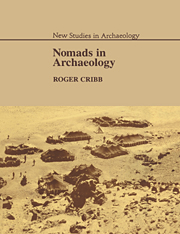Book contents
- Frontmatter
- Contents
- List of illustrations
- List of tables
- Preface
- 1 Introduction
- 2 Origins and definitions
- 3 Nomad pastoral economy
- 4 Residence, descent and territory
- 5 Nomads – the invisible culture?
- 6 Nomad architecture and domestic space
- 7 Ali's camp: a nomad household campsite
- 8 The structure and location of nomad settlements
- 9 Sariaydin Yayla
- 10 The lost world of Nemrut Daḡ
- 11 Nomad archaeology: an assessment
- 12 Towards a model of unstable settlement systems
- References
- Glossary
- Index
2 - Origins and definitions
Published online by Cambridge University Press: 23 September 2009
- Frontmatter
- Contents
- List of illustrations
- List of tables
- Preface
- 1 Introduction
- 2 Origins and definitions
- 3 Nomad pastoral economy
- 4 Residence, descent and territory
- 5 Nomads – the invisible culture?
- 6 Nomad architecture and domestic space
- 7 Ali's camp: a nomad household campsite
- 8 The structure and location of nomad settlements
- 9 Sariaydin Yayla
- 10 The lost world of Nemrut Daḡ
- 11 Nomad archaeology: an assessment
- 12 Towards a model of unstable settlement systems
- References
- Glossary
- Index
Summary
The weapon is his companion …
Who knows no submission,
Who eats uncooked flesh,
Who has no house in his lifetime.
(from a Sumerian text, in Chiera 1924, p.20)While the quest for the origins of nomadic pastoralism is not the central theme of this work, the issue must be raised if only because it has formed the focus of so much archaeological work. Yet the origins of nomadism may not be of quite the same significance as other origins – such as the origins of food production and of urban life. In the latter instances we are dealing with major systems transformations which require extremely complex explanations and models and which are part of a general trend towards organizational complexity and increased energy capture. The advent of nomadic pastoralism has its place in all this but if; as suggested earlier, it is peripheral to the main line of cultural evolution, then it may not require the same level of explanation. Perhaps nomadic pastoralism cannot be said to have had a precise origin, or perhaps it has had many origins in many places and at different times. If, as argued by some (Khazanov 1984; Gilbert 1983; and also in this work), nomadism is an unstable and fluctuating phenomenon involving a heavy commitment to pastoralism, then we would be far better off studying those sets of conditions under which it emerges or declines than in searching for origins or building causal models.
- Type
- Chapter
- Information
- Nomads in Archaeology , pp. 9 - 22Publisher: Cambridge University PressPrint publication year: 1991

